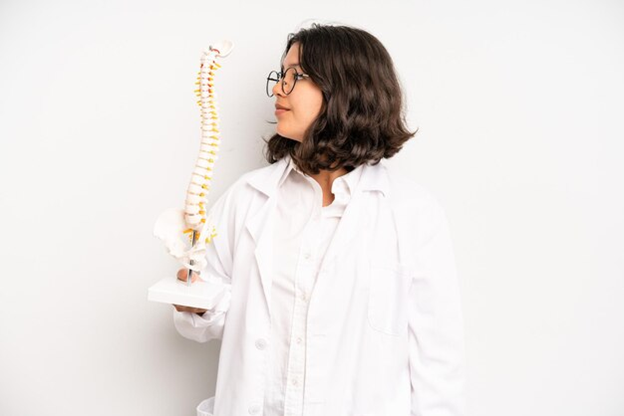Postural spine disorders occur when our spine doesn’t align properly. This can cause many problems, including back pain or fatigue. The spine is crucial in keeping us standing straight and balanced, like the frame of a house. When it isn’t aligned, it can lead to discomfort and health issues. By understanding the causes, symptoms, and solutions, individuals can better manage these problems.
The Role of Posture in Modern Health
Good posture is crucial for our health every day and always. Having the right posture means fewer injuries happen to us later. It ensures our muscles and ligaments aren’t strained for long.
Using phones and tablets changes how we sit and stand now. Many of us end up slouching over screens every day. This constant slump can cause various postural spine disorders eventually.
In India, many people deal with posture issues daily because of lifestyle. Our long hours and bad setups at work don’t help at all. Raising awareness about better posture can prevent the need for postural spine correction.
Defining Postural Spine Disorders
Postural spine disorders arise from everyday habits we form over time. These differ from structural spine issues that often stem from injuries or genetic causes. Postural issues develop gradually and can sometimes be remedied with changes in lifestyle, while structural issues could require medical treatment.
Common postural troubles include lordosis, which occurs when the lower back curves inward more than it should. Then there’s kyphosis, where the upper spine curves outward, leading to a hunched appearance. These aren’t just visual concerns; they result in discomfort and strain on your muscles.
Recognizing these problems early can significantly impact personal health. The sooner these are spotted, the more manageable they are. Taking steps towards understanding them helps in correcting them effectively. Quick attention guarantees a healthier spine and limits potential long-term harm.
Root Causes of Postural Spine Disorders
Long hours of sitting lead to bad posture and discomfort. Furniture that is too high or low can cause further issues. Weak muscles make maintaining a good posture hard for anyone.

Culture influences how people hold their bodies daily. Some sit on the floor which changes how spines curve with time. Physical activities are often not prioritized in schools, leading to weaker muscles.
People spend many hours looking down at small screens now. Laptops and phones are used for hours every single day by all ages. People need to change these habits for better spine health.
Identifying Symptoms and Early Warning Signs
Recognizing symptoms is very important for addressing potential issues early. Common signs include back pain that lingers and stiffness that happens often. You may also feel discomfort reaching down into your arms or legs. These signs mean there could be issues with how we hold ourselves.

Ignoring these signs can make them worsen quickly. What was once a rare pain might become an everyday companion. Easy tasks, like walking, start to feel very hard to complete. Mild discomfort can slowly turn into big challenges with day-to-day movements.
If your back pain won’t go away, it’s time to visit a doctor. Catching problems early ensures the best chance to fix them fast. If changing your routine doesn’t show results, talk to a specialist right away. Getting professional help can keep small issues from turning into major health problems.
The Ripple Effects of Untreated Postural Disorders
Ignoring issues with postural spine disorders can cause lasting problems. Every regular task might become exhausting, turning simple actions into hurdles. Reduced bending and moving can severely hit life’s quality. Such everyday tasks might hurt and become surprisingly tough.
Physical pain often burdens the mind as well; discomfort regularly causes irritability and worry. Constant tiredness steals one’s pep and drive, making every day feel harder. Addressing these symptoms early often turns such mood changes around.
Without timely care, minor aches may stick around forever. The spine can settle into a crooked shape over time. Adopting proactive measures prevents bad issues from sticking around.
Effective Solutions and Treatment Options
Start improving posture by adjusting your surrounding setup first. Try using supportive chairs and desks that help the spine stay straight. Introduce exercises like yoga or pilates that both strengthen the core effectively. Taking regular stretch breaks during your day can really make a big difference.
In India, traditional remedies like Ayurveda provide aid for back issues well. Modern solutions include physiotherapy and chiropractic care for recovery. Both have benefits depending on personal needs and preferences of individuals. Often, combining the two approaches results in a more comprehensive treatment approach.
Consider seeing professionals when lifestyle changes are not improving your pain. Experts can offer personalized advice and care plans tailored specifically for you. They guide patients on important exercises or treatments suitable for their condition. Seeking early guidance helps prevent worsening of postural spine disorders and supports effective postural spine correction.
Practical Tips for Spinal Health and Posture Maintenance
Maintaining healthy posture is crucial to avoiding back issues. To get started, be sure to always stand straight with your shoulders relaxed.
Regular stretching prevents posture-related problems; stretch once in the morning before you head out. Strengthening exercises like planks and bridges help maintain your core muscles.
The furniture we use daily can impact our posture quite a bit. Opt for an ergonomic chair that supports your back adequately, and make sure your screen is positioned correctly at eye level.
Emphasizing the Importance of Professional Guidance
Consulting a specialist is crucial for managing postural spine disorders. Dr. Jyotheswara Reddy, for instance, helps create personalized plans.
Professional help ensures you follow the right steps. Personalized plans focus on needed exercises and changes.
Early assistance can stop further issues. Awareness and early action aid in postural spine correction.


